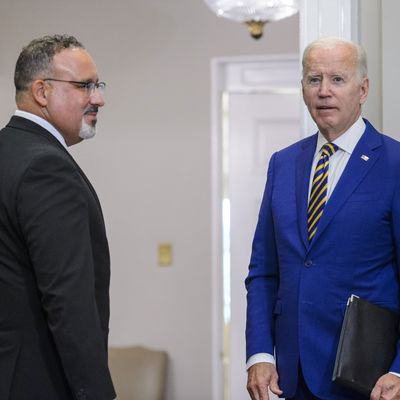
When President Joe Biden announced Wednesday that he’s going to cancel as much as $20,000 in federal student-loan debt for some borrowers, a side-debate immediately sprang up to consider it in the bigger project of the White House’s most important economic policy: bringing down inflation and keeping this weird economy from toppling over. Some prominent Democrats who were early in voicing concerns about the inflationary effects of last year’s COVID-stimulus spending — a prediction that proved quite accurate — are now raising the flag that student-loan forgiveness might make our inflation problem worse:
The concern of administration-friendly economists who are also inflation hawks, like Summers and Furman, is based partly on the sheer size of this program, estimated to be roughly $330 billion — an amount of money that has the potential to warp an otherwise delicate economy that’s only starting to see inflation come down. It’s worth taking these arguments seriously, of course, given the recent track record of those making them. (It’s very good.)
But there are also reasons to be skeptical. Despite the griping about the aggregate price tag, it’s going to have the biggest impact on people with the smallest amount of federal student loans — people who pay about $220 a month, which is the median monthly payment. That’s a $2,664 annual benefit — good, but it’s not like anyone will be rolling around in cash. To put that into perspective, that’s less than Supplemental Nutrition Assistance Program benefits for individuals in most states, and far smaller than the pandemic-era enhanced unemployment insurance payments that are blamed, in part, for the current state of inflation.
Then there’s the question of how big the benefits of the program will be for those seeing some level of debt forgiveness. The majority of the benefits go to people who would have the hardest time paying off the debts — particularly those who took out loans and never finished college. The more education one has, the higher the debt load tends to be, with doctors taking out about $200,000 on average. For people with larger amounts of debt who would qualify for forgiveness, it’s important to remember that they are going to start paying hundreds, if not thousands, of dollars more every month as the government restarts student-loan payments after freezing them for two years during the pandemic. For that larger pool of borrowers — overall there is some $1.3 trillion in student debt outstanding — that means they will have a new monthly expense, and collectively that will exert downward pressure on spending, and therefore demand, among the highest earners, in theory counteracting some of the inflationary effect of the forgiveness.
Still, the possibility that this could hurt, rather than help, the economy is real. It’s hard to ignore the fact that the highest wage gains during the pandemic have been among those who’ve made the least, those who are less likely to stash away their extra income, meaning there’s been a broader increase in demand. And the increase in taxes from the Inflation Reduction Act, which were supposed to tamp down prices, are all but wiped out.
I don’t think this is unreasonable to consider. Roughly $5 trillion in stimulus has distorted the economy in major ways, stoking demand while supply chains all over the world have broken down, leading to higher and higher prices. Those higher prices hurt a lot of working-class and middle-class Americans. The Fed, as well as the Biden administration, claimed that inflation would be “transitory” for far too long, even after it was evident that it was here to stay. Student-loan forgiveness is certainly a stimulus, but not all economic stimuli affect the economy in the same way.
But to look at the relief program another way, it costs about as much as three months of the Federal Reserve’s pandemic-era bond-buying program, which was a boon to corporate America as it reaped record profits. The reality is that after multiple huge and broad giveaways that kept the economy from teetering into the abyss, student-debt forgiveness looks extremely targeted and small in comparison. The bigger shock will probably be that, after two years on pause, millions of people are going to have to start paying anything at all.






























